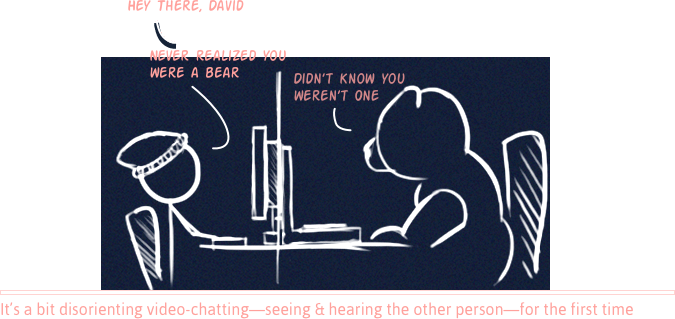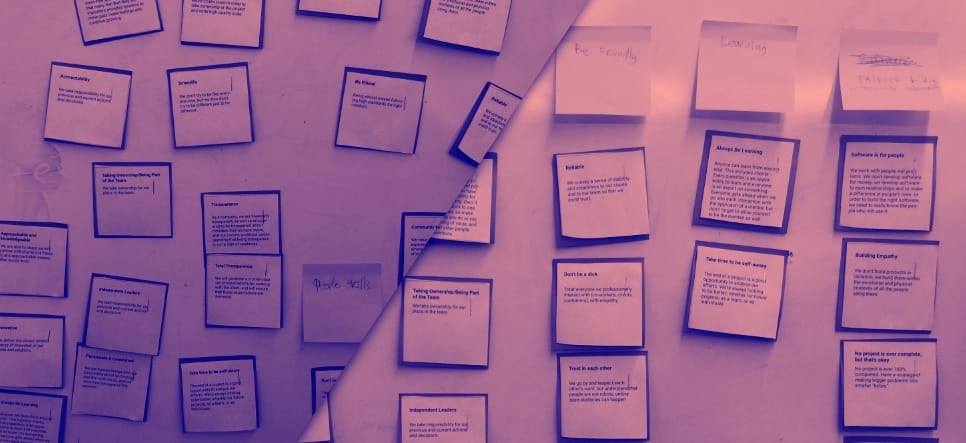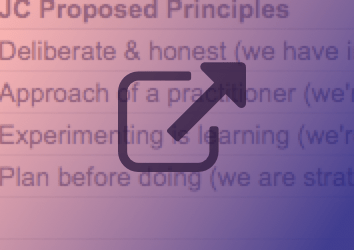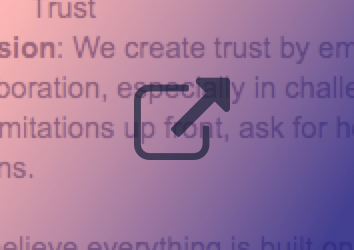Implementing Core Values into a Small Company
While I was at Coshx Labs, about 15 people worked together across four different timezones. As time went on, I felt formal guidelines for the company would help us work tighter as a group, as well as with clients. Here’s how I went about getting company core values created and accepted amongst my peers.

What are core values and why have them?
Core values in a company are a set of guidelines and principles to which everyone aligns their work process and interactions with clients and fellow employees. In a sense—a northstar when approaching any situation where the answer is not certain.

Another reason to have core values in a company is to bring a sense of community. Coshx Labs was comprised of people in the tech and software development field working in multiple cities and remotely. Without a Coshx identity, we were just a bunch of contractors who shared the same Slack channel, working on different client projects.
Is this all wishy-washy kumbaya jargon? I do not feel it is. Having worked previously at places that had company core values, I feel that the core values helps greatly to align intent with others and to quickly onboard new people to how the company operates. With all that said, let's get into how I got started with the Coshx Labs core values.
Observe and Influence
Many companies don’t have defined core values and they operate just fine. There is no rule that says core values makes a better company. For Coshx Labs, a company that liked to work fast, I did not sense an immediate need for company core values, as the group was small enough when I joined that we could resolve things within a sensible timeframe.
However, the team grew a bit bigger and from time to time, complex situations arose within the company and with clients. One person wanted to approach a situation from this direction and the other person the opposite. While going through agile sprint retrospectives helped get people on the same page after the fact, certain mishaps seemed to always repeat themselves. I started to wonder—maybe having company core values would be something that would help us work better as a team.

Get co-sign from those in charge
For core values to be of any use, the leaders of the group have to not only approve of them, but also advocate core values at every opportunity. I brought the idea up with the Coshx boss man, Ben, to see if he also saw a need for core values.

It is easy for a person to agree with you when something sounds good. However, simply agreeing something sounds like the right thing to do does not help to find out whether or not my idea for core values was the right course of action for us as a company. I knew there was a good chance of that happening, which is why I came up with some initial core values statements from my observations and conversations with others, as well as what I envisioned the company to be in the future. When I presented this initial document to the boss, I got the result I wanted—to motivate him into action and give constructive feedback on the idea. With the boss onboard, I then needed to figure out how to get everyone involved in the core values creation process.
Brainstorming across locations
With Coshx members in different locations, it meant that a lot of us were not on the same client projects—interactions between some of us only existed in the Slack channels. With that in mind, the boss had the desire to get everyone to provide input on core values early on. Instead of getting into a big brainstorming session where only the loudest extroverts were heard, one-on-one brainstorming discussions between Coshx members who didn’t interact with each other often was the way to go.


In the one-on-one discussions, each group was tasked with coming up with three value statements and examples, which were then entered into a Google form. By the end, 30+ core value ideas were generated. Everyone got to know each other a bit more personally and had direct input into how the company core values would be shaped. And with that came the fun part—analyzing and trying to make sense of these ideas (aka data points!)

Making sense of the data
A good first approach I use often when dealing with large amounts of data points is to try to group & categorize them, aka affinity mapping. To make things easier to group, I make a printout of each idea in the shape of a post-it card and then put the cards up on a wall. From my experience, physically grouping things makes it easier to move them around and encourages rearranging them often.

Took multiple rounds of grouping before I found a pattern that made some sense. The goal is to try to have the data points distribute evenly across groups but do not force it if it doesn’t happen organically.
After I felt I got a decent grouping, I put the data points back into digital form and got another colleague, Sammy, involved in the data analyzation process. Having more than one person on any type of data analysis helps build confidence in the interpretation of the data, as different perspectives allow for more edge-cases and flaws to pop out, as well as forcing you to vocalize your insights. With his POV and interpretation of the data and my analysis, we finalized the data points into six categories:
- Trust
- Execute & Collaboration
- Ownership
- Respect
- Learning
- Building Products*
* Interestingly, the category “Building Products” was highly different from the other five categories. This category was specific and tangible in a “how to do a thing” way, while the other categories were more abstract and open to interpretation. It was insightful to see that we Coshx people, as a whole, felt a need for “building products” guidelines—perhaps because of interactions with clients who don’t know what Agile software development entails or because of differing preferred methodologies internally.
 In collaboration with Sammy, we refined the category names and ended up with a more even grouping of data points in each category.
In collaboration with Sammy, we refined the category names and ended up with a more even grouping of data points in each category.
Declaring and defining core values
With the categories realized, the next task was for Sammy & I to create concise core value statements and definitions for each category. Based on the data and our interpretation of it and with me spearheading the direction of content, we went back and forth over statements & definitions in Google docs and video chats. Below are the points we focused on when coming up with these core values:
Summarize category datapoints into one blurb
Data points are in the same category when they are similar in one way or another. The blurb serves as the definition for that category. When the definition was realized, we moved into creating a core value statement for the category.Throw it on the wall, force the conversation
When in doubt about whether what you’re writing is in the right direction, try to create total opposite or hyperbolic statements and ask, “Why are they not true?” It helped force Sammy & I to think out loud and narrow down our intent.Decide your tone
The tone of the core values decides how the reader will perceive them. We did not want ours to command our coworkers to do something nor did we want to tell them what not to do. We decided on a tone along the lines of guidance when in uneasy scenarios.Take a stance: the data is to influence, not drive
Data is not all that effective without context. I worked, collaborated, & had fun with fellow Coshx employees. I understood and empathized with these people. With that context and observation in mind, along with the data points, helped me create a narrative for the Coshx core values.Get the phrasing down, do not need to finalize now
It was important for us to get some quality content together at this point, but we also understood the finality of the core value statements would involve feedback from the rest of the team.A week of collaborative editing & revisions went into deciding if the content was “correct” and if that was how we, as a company, wanted to ideally be. Eventually, we came up with a set of core values and definitions we were confident in. But let’s see if these core values resonated with the rest of Coshx like they did with us.
Presenting the core values to the crew

The proposed core values & definitions were shown to the boss and he cosigned them. The proposed core values were then sent to everyone before an all-hands meeting about the topic was held—I found it best to let people get a preview of the content before a meeting so that the information can sink in and they can have better prepared questions.
In the all-hands meeting, I went into explaining the process—from why I thought we needed core values to the initial conception, the 1-on-1 meetings, to the collection and synthesis of data, and the direction from which the value definitions and statements were made. These details helped foster trust from the group, and conveyed that we didn’t do things arbitrarily—that there was a logical method to it. The boss went over each core value and gave examples. It’s important to have the leader present core values, as it shows that those with the most power committed to these values.
The meeting wrapped up with a Q&A session with some questions from the group (e.g. what if things change in the future?), but nothing problematic. But even though the general consensus from the group was that the core values felt good, we were aware that questions and revelations do not always come immediately, and not everyone likes to speak up in big groups. We decided it was worth collecting feedback after a few days of individual reflection, so a survey was sent to everyone.
Survey & Feedback
The survey we created asked the person to rate each proposed Coshx core value statement & definition from 1 to 5 according to each of the following:
This value reflects my own belief
There was insight to be gained from knowing if the Coshx values were relatable to an individual’s own code of ethics. Afterall, most people do not want to handle having two personalities.Coshx demonstrates this value currently
This gauged whether the core values were something that we were already excelling at or something we had to strategically strive towards.This value is important to our success as a team
Things can sound good in general. But let’s see how much each person feels a particular core value is actually vital to the group’s success.Everyone responded to the survey and the sum of the results were positive. In addition, the survey also provided individual comments that were used to revise the language in the core value definitions. For example, in the category of trust, someone wrote:
This is a super challenging one for me. Transparency does not mean saying whatever you are thinking. I am glad to be challenged to be more transparent, and also more thoughtful. Coshx has provided surprising challenges in that area. I think we as a team could also live up to this a bit more.”
Coming to fruition: Coshx Core Values
After the last revision, this first attempt at designing Coshx core values was concluded. It took months from the initial kickoff discussion to get to this point, but the payoff was a high level of confidence in the core values we created and satisfaction with how we went about getting there. Here are the core statements and their definitions:


